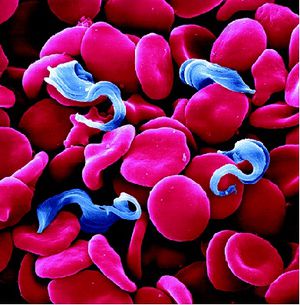African Trypanosomiasis: Difference between revisions
| Line 6: | Line 6: | ||
<br> |'''NCBI: [http://www.ncbi.nlm.nih.gov/Taxonomy/Browser/wwwtax.cgi?mode=Info&id=5691&lvl=3&lin=f&keep=1&srchmode=1&unlock Taxonomy] Genome: <font size="2">[http://www.ncbi.nlm.nih.gov/genome/?term=trypanosoma+brucei Genome]</font>'''|} | <br> |'''NCBI: [http://www.ncbi.nlm.nih.gov/Taxonomy/Browser/wwwtax.cgi?mode=Info&id=5691&lvl=3&lin=f&keep=1&srchmode=1&unlock Taxonomy] Genome: <font size="2">[http://www.ncbi.nlm.nih.gov/genome/?term=trypanosoma+brucei Genome]</font>'''|} | ||
===Description=== | ===Description=== | ||
African Trypanosomiasis also called Sleeping Sickness is caused by <i>Trypanosoma brucei</i>, a unicellular parasitic protozoan. There are two separate subspecies which cause sleeping sickness in humans, <i>Trypanosoma brucei gambiense</i> which accounts for around 98% of cases and Trypanosoma brucei rhodesiense which accounts for the remaining 2% of cases. African trypanosomiasis is limited in epidemiology to areas of Sub-Saharan Africa. <i>Trypanosoma brucei</i> was first described as the causative agent of Sleeping Sickness in 1901. Although by the mid-1960s the disease had been largely eliminated, the disease saw a reemergence countries in which the disease was endemic gained independence and their health systems subsequently collapsed. The protozoan is spread via the tsetse fly, and key symptoms of the disease include headache, fever, stiffness and later coma and death. | |||
==Pathogenesis== | ==Pathogenesis== | ||
===Transmission=== | ===Transmission=== | ||
Revision as of 15:24, 21 July 2014
[2]]]

Etiology
Taxonomy
| Domain = Protozoa | Phylum = Sarcomastigophora | Class = Zoomastigophora | Order = Kinetplastida | Family = Trypanosomatidae | Genus = Trypanosoma | Species = T. brucei
|NCBI: Taxonomy Genome: Genome|}
Description
African Trypanosomiasis also called Sleeping Sickness is caused by Trypanosoma brucei, a unicellular parasitic protozoan. There are two separate subspecies which cause sleeping sickness in humans, Trypanosoma brucei gambiense which accounts for around 98% of cases and Trypanosoma brucei rhodesiense which accounts for the remaining 2% of cases. African trypanosomiasis is limited in epidemiology to areas of Sub-Saharan Africa. Trypanosoma brucei was first described as the causative agent of Sleeping Sickness in 1901. Although by the mid-1960s the disease had been largely eliminated, the disease saw a reemergence countries in which the disease was endemic gained independence and their health systems subsequently collapsed. The protozoan is spread via the tsetse fly, and key symptoms of the disease include headache, fever, stiffness and later coma and death.

